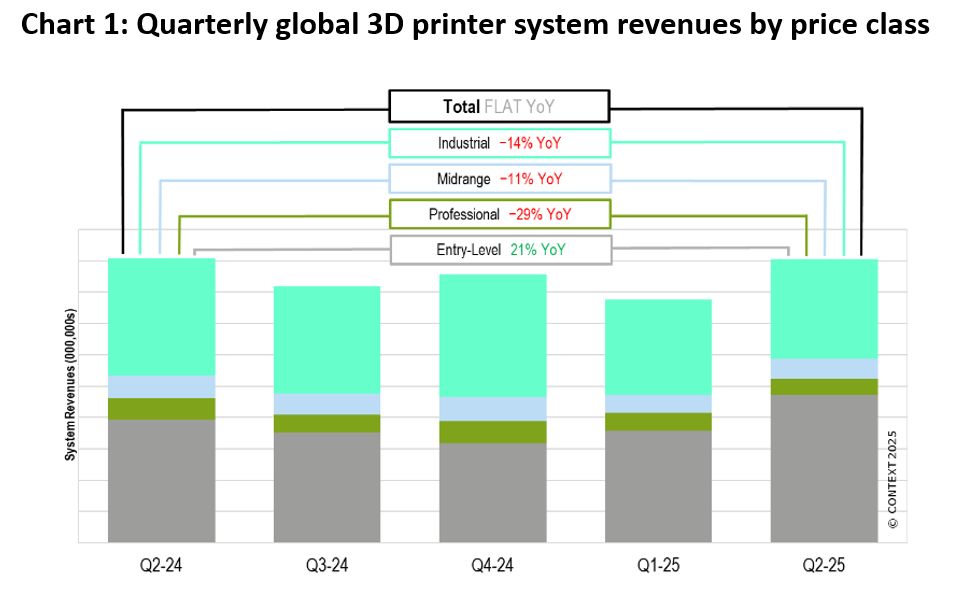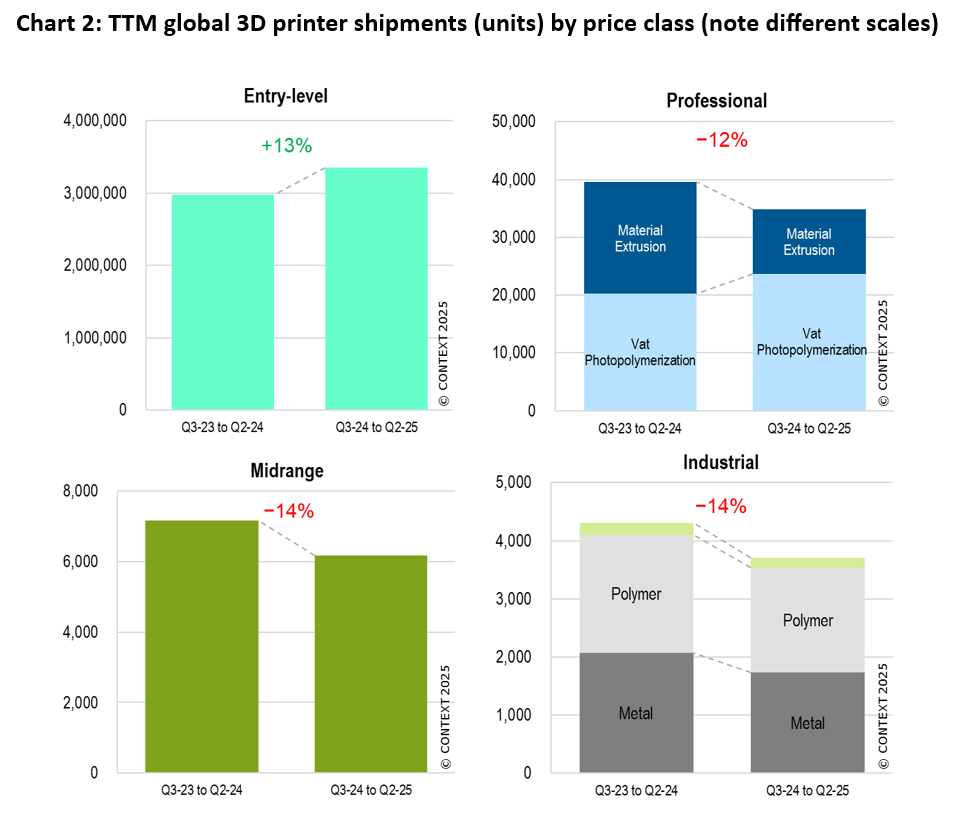London, 9 October 2025 – The global 3D
printer market continued to show starkly divergent trends in the
second quarter of 2025, according to the latest analysis by global
market intelligence firm CONTEXT. The consumer-centric Entry-level
market continues to excel while the high-end of the industry remains
stuck in slowdown mode as downstream capital spending stalls and
consolidation continues.
The trend of disparate market
performance continued into the second quarter. Weak demand from
tariff-paralysis and high interest rates made for difficult market
conditions in the Industrial and Midrange segments. In contrast, the
Entry-level space continued to thrive, with key players even making
moves to go public, highlighting the segment's sustained momentum.
Overall aggregate hardware system
revenues remained flat year-on-year (YoY). A +21% surge in revenues
from Entry-level printers, driven by strong shipments from vendors
like Bambu Lab, was offset by significant downturns in all other price
categories. Revenues from Professional systems fell by -29%, while
Midrange and Industrial revenues dropped by -11% and -14% respectively.

Industrial and Midrange Systems
High interest rates and the fallout
from widespread company consolidation created another challenging
quarter for the high-end of the market. Global Industrial 3D printer
shipments fell markedly in Q2 2025. This weakness was compounded by
business distractions from bankruptcies, such as that of Desktop
Metal, and complex mergers; the newly combined Nano Dimension
(including Markforged and Desktop Metal for the period) saw its
aggregate shipments of the three collective companies fall
precipitously from a year ago. However, there were bright spots: HP
saw impressive shipment growth in the quarter, largely driven by its
unique upgrade strategy, and Stratasys posted nice growth as well. In
the crucial metal PBF segment, China's Eplus3D took the top spot for
units shipped and, alongside Velo3D saw YoY unit shipment growth,
while stalwarts EOS and Nikon remained revenue leaders despite both
seeing marginal unit shipment declines from a year ago.
The Midrange category saw a similar
YoY shipment decline to the Industrial price-class. The downturn was
most pronounced for Western vendors, including 3D Systems (which
continues to get smaller each period) and Stratasys, while some
Chinese vendors like UnionTech saw shipment growth fuelled by domestic
demand. Flashforge, a standout performer on a trailing-twelve-month
basis, saw a small quarterly dip in shipments in Q2 2025.
Professional Printers
The significant YoY drop in
shipments of Professional printers was driven entirely by the
collapse of the material extrusion (FDM/FFF) category, where
shipments cratered. This segment, once the dominant force in the
professional space, has been significantly impacted by the rise of
capable, lower-priced Entry-level machines. In contrast, vat
photopolymerization shipments in this category held steady, as
vendors like Formlabs continued the successful refresh of key
product lines.
Entry-Level Printers
The Entry-level category was again
the standout performer, again seeing strong YoY shipment growth.
This growth was driven by continued strong demand for products from
brands like Bambu Lab, which not only saw its shipments rise again,
but also introduced new products. The quarter was also notable for
the news that Creality, a long-time leader in the space, issued
plans to go public. While Creality saw a shipment decline as it
realigns its reporting for its IPO, the move signals the growing
maturity and financial significance of the consumer market. The
segment also saw record-breaking crowdfunding success for
Snapmaker’s new multicolour FDM printer, demonstrating robust
consumer enthusiasm.

Outlook
While the Entry-level segment
remains strong, persistent headwinds from high interest rates,
tariffs, and inflation are expected to continue suppressing capital
expenditures for high-end systems for the remainder of 2025. In a
welcome move for the industry, the US Federal Reserve cut interest
rates in September 2025, with more cuts anticipated before year-end.
However, it is expected that it will take several such cuts before
capital spending is fully restimulated.
While many OEMs continue to report
strong end-market engagement and pent-up demand, the recovery for the
Industrial segment now looks to be pushed out. We don’t project a
significant rebound to begin until 2026, when lower interest rates are
expected to finally unlock renewed investment in capital equipment.
Regional on-shoring initiatives and the need to overcome supply chain
disruptions still present major opportunities for agile additive
manufacturing once business conditions improve.
* Price classes: Entry-level
<$2,500; Professional $2,500–$20,000; Midrange $20,000–$100,000;
Industrial $100,000+